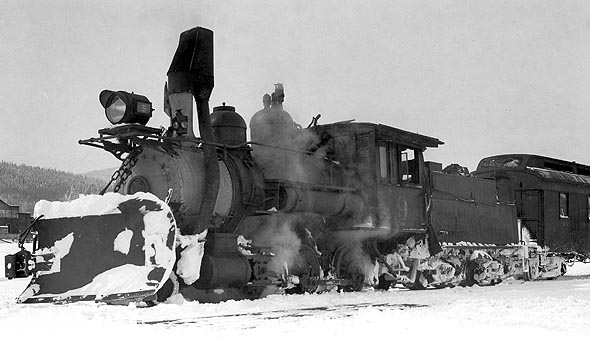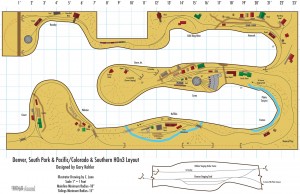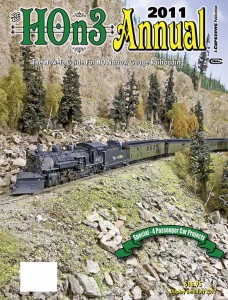 By Duncan Harvey/photos as noted
By Duncan Harvey/photos as noted
The recent advent of ready-to-run equipment in HO scale narrow gauge (HOn3), and the almost simultaneous release of several new railroad books dealing with Colorado narrow gauges, combined with articles on various web sites have caused some interesting thoughts. These new offerings are bringing more modelers into the fold of narrow gauge and recently even more so into the brotherhood of HOn3 modelers. Newly released books attract modelers to the railroads they cover. These two concurrent events seem to me to be making a sort of watershed period for potential model railroaders, a time when many new adherents will be choosing the prototype they wish to follow.
It is pretty safe to say that most narrow gauge modelers, who model a prototype road, do so with the Rio Grande Southern and/or the Denver & Rio Grande Western as their chosen subject. The other Colorado roads have a significantly smaller following and the roads outside Colorado have even fewer. Why is this? Is it that these two roads are possessed of the most attractive features for a model railroad? Or, is there something else at play? I think it is the latter.
I think more people model the RGS and the D&RGW because these two roads are/were more visible. By that I mean, the D&RGW was still running narrow gauge equipment into the 1960’s, before the narrow gauge portion was purchased and became a fine tourist railroad. The RGS operated into the 1950’s before it quit. This has afforded many people, who are today’s model railroaders, the chance to see and ride these two railroads. As a result many more photographs have been taken of both roads and a great number have been in color. This is not as true for the other Colorado roads. Most were out of business before personal cameras were in vogue and before much color photography was possible. So, a far greater mass of information and personal experience is present for the modelers of the RGS and the D&RGW.
Therefore, it seems to me the reason for the popularity of the RGS and the D&RGW as modeling subjects has more to do with a “lack of depth of knowledge” of other roads and the difficulty of modeling these other roads when little information is available, than it has to do with these two roads being inherently better to model. It is hoped this article will help off-set this lack of knowledge for at least one of these other roads. Maybe it will encourage others to contribute articles about why they model the roads they do. This article is all about the reasons that make the Colorado and Southern an ideal prototype to model.
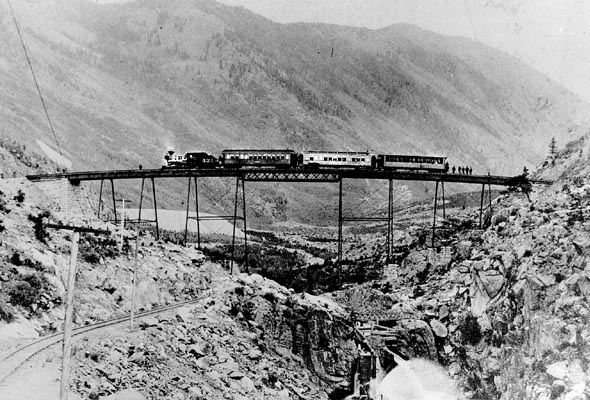
The world-famous Georgetown Loop as seen in the 1880s. Note Mason Bogie No. 42 on the point. Photo Courtesy Rick Steele Collection.
The Colorado & Southern (C&S) and its related and associated railroads are an often overlooked subject for model railroads. Yet, the C&S was the largest narrow gauge railroad contained wholly within the state of Colorado. It was made up of several other railroads that were joined together after the repeal of the Sherman Silver Purchase Act, in 1893. This “empire” included the: Denver, South Park and Pacific (DSP&P); which became the Denver Leadville and Gunnison (DL&G) when taken over by the Union Pacific and the Colorado Central (CC), which became the Union Pacific Denver & Gulf (UPD&G) when brought under Union Pacific control. These two railroads formed the basis of the C&S upon its formation in 1898. There were other railroads that were closely associated with the C&S as well. These were the: Argentine Central; Gilpin Gold Tram; Denver Boulder & Western (DB&W); which became the Colorado & North Western (CNW); and the Georgetown, Breckenridge & Leadville (GB&L). I will generally refer to all of these simply as the “C&S.”
It is my contention that the C&S is the best, and most viable, prototype Colorado narrow gauge railroad to model. The reasons for this are many and varied. They range from the variety of locomotives and rolling stock, the advanced engineering practices employed in construction of equipment, the spectacular and varied scenery traversed, the intriguing history and legends surrounding the road, the mysteries encountered when modeling this road, the architecture of the structures, the communities served and finally the kits and modeling items available. These add up to a very strong charisma possessed by the C&S and an ease of modeling not equaled, let alone surpassed, by other roads.
Let’s take a look at each of these categories to see just what is being proposed. Maybe then, you too will be drawn to model the C&S, or one of its related roads.
Why is the C&S such a great railroad to model?
The C&S, and its related railroads, operated a wide variety of very colorful equipment. Consider the motive power. The roster for this road covers everything from small tank engines and “dummy” locomotives, to 0-6-0’s, about four versions of 2-6-0’s, a 4-4-0, seven different versions of 2-8-0’s, two versions of 2-6-6T’s and the 2-8-6T’s. The DSP&P, and its descendants, including the C&S, were the only narrow gauge railroads in Colorado to run Mason Bogies. These were very colorful early locomotives with a fascinating wheel arrangement (2-6-6T and 2-8-6T) and intriguing engineering design, in that the boiler swiveled above the drivers, much like an articulated engine. The C&S was the only Colorado road to run an oil burning locomotive during its general revenue producing days. Furthermore, it had an outside frame 2-8-0 locomotive, very similar to the D&RGW C-25. It used narrow gauge Shays on the Argentine Central, the Gilpin Tram and even for a while, on the DL&G and had the only three truck, narrow gauge Climax built, on the Denver, Boulder & Western. In addition, the C&S family of locomotives sported more smoke stack designs than any other Colorado railroad. There were eight, including the Congdon, Nesmyth, McConnell (or pancake/sunflower), Como, diamond, straight (or shotgun), capped and Ridgway (the famous “Bear Trap”). What a visual feast these different smoke stacks provide! Some C&S locomotives also carried their air reservoir tanks mounted on top of their boilers. Again, the C&S was the only railroad to do this. It makes C&S locomotives stand out from the rest of the pack.
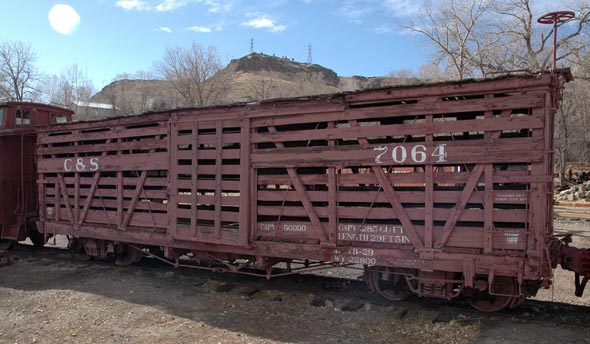
C&S stock car No. 7064 has been restored and resides at the Colorado Railroad Museum in Golden, Colorado. Chris Lane Collection
Rolling stock was likewise unusual and colorful. The C&S operated the most modern rolling stock of any Colorado narrow gauge railroad. A number of their cars sported steel (composite) underframes and rode on Bettendorf trucks. They were the only Colorado narrow gauge railroad cars so outfitted, until some were sent to the RGS. The C&S was first to set up their equipment with Westinghouse air brakes and first to employ knuckle couplers. They had the first and only enclosed automobile car to run on the narrow gauge roads of Colorado. Some box cars had roof hatches for loading dry granular materials and the DSP&P had very large, for the time, outside braced box cars used for carrying charcoal smelters. The C&S had side dump cinder cars unlike anything run on other roads. The cars wore a greater variety of lettering schemes than any other road, due to the number of composite roads included and the variations in each of those road’s lettering schemes.
The C&S refrigerator cars were the most colorful in the state. It is somewhat a mystery and point of contention between C&S modelers, as to just what the exact color of the Tiffany reefers was. Most lean toward their being white. But, there are strong arguments for their being a light mint green, or a pale yellow. We do know the C&S had bright yellow reefers in the later years. There is evidence they had orange reefers. And there is some pretty convincing evidence they ran red reefers. So, apparently, four different colors of reefers existed! What other railroad can claim that variety?
Passenger cars had bull nosed, duckbill, and a modified duckbill roof. Sides were sheathed in plain boards, like most other road’s cars, but some cars also had board and batten type walls. The windows were square cut, had rounded top corners, were tall, or short and wide. Such an interesting variety of car construction! Cars were built by numerous builders such as Barney & Smith; Bowers, Duer & Company; Hallack & Brother; Gilbert, Bush & Company and others. There were even repurposed cars from New York City’s elevated railways in the early years, as well as home built cars. Two narrow gauge railroads in Colorado used Pullman sleepers. These were the DSP&P and the D&RG. Again, an interesting and different car, limited to just a couple of roads, one of which was the C&S empire.
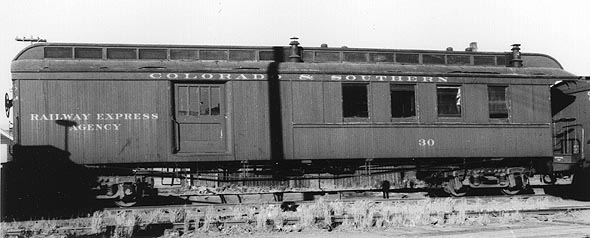
Colorado & Southern combine no. 30. Photo courtesy Mallory Hope Farrell
The C&S ran special “fish trains” on weekends to take fishermen up the Platte Canyon, and their combines and mail cars were some of the very few Colorado narrow gauge cars to employ fish racks. These were wooden floor racks built into the cars to accommodate fish caught by fishermen who were dropped off along the line early in the morning and then picked up again at the end of the day.
[Editor’s Note: The discussion of “fish racks” is open to a bit of debate. It appears to be a generic term for an appliance applied to cars handling freight rather than for the sole purpose of handling fish. This from the 1949 Car Builders Cyclopedia: Fish Rack – see Floor Rack: A rack built for use on the floors of some types of express and baggage cars and in refrigerator cars to provide for certain classes of lading where leakage due to melting ice occurs. A floor rack is usually constructed of strips of wood cleated together or separated by filler blocks and bolted together, the complete rack being laid on the floor proper. This rack allows circulation of air and supports the lading above the drainage or any water which may accumulate. The size of the rack depends upon convenience in handling and in some cases hinges are used to permit folding up against the side of the car. Cars known to handle ice and/or fish packed in ice usually had metal drip pans and drains below the fish racks. The C&S cars lacked these and with wood floors, you’d have to assume that ice was a once-in-a-great-while occurrence. More likely the cars were used to hold the fishing creels and poles. Interesting, nonetheless. —Chris Lane]
The road used short four-wheeled cabooses, called waycars, all through its operational years. The cars were of several different lengths and cupola configurations (no cupola, centered, and offset to one end). Again, they were of at least two different colors, possibly red and white, or light yellow.
The DSP&P railroad used what appear to be stock cars in their passenger trains. The cars were run at the front of the train and appear to have been used as early baggage cars. They had screen doors and stoves installed! What other railroad did this sort of thing? The freight fleet, in later years, was made up of three “phases” of cars. The first “phase” were all the inherited cars. These were wood framed, truss rod cars that rode on 4′ arch bar trucks. “Phase 2” cars were those with wood frames and truss rods, but riding on Bettendorf trucks. The final “phase” cars were those with the steel (or composite) underframes riding on Bettendorf trucks. Both the early locomotives and the way cars sported lettering with red drop shadow. The locomotives had gold lettering with the red drop shadow, while the way cars had black lettering with the shadow.
The scenery traversed by the C&S was some of the most beautiful and spectacular in all of Colorado. People often point to the D&RGW’s “Ledge”, on the Highline from Durango to Silverton, as an example of the spectacular scenery that road ran through. It is true, that is a spectacular stretch of road. But, it is just in one place and extends for just a short space. Much of the rest of the road’s scenery is not that spectacular.
People have much less exposure to the “Palisades” of the DSP&P/C&S. In many ways this is just as spectacular and in some ways more so, because of where it was built (high on the face of a sheer rock cliff) and the fact it made use of hand-fitted stones with no mortar. Today it is still standing and is just as solid as when first built! Now, add to that scenes like the Georgetown Loop’s Devil’s Gate Viaduct, Sherrod Loop, the crossings of the Arkansas Valley, Alpine Pass, Boreas Pass, Clear Creek, Mt. McClellan, Trout Creek, and the like, not to mention the second “Grand Palisades” the road started to build over Ohio Pass, and I think a rather convincing argument can be made that the C&S ran through even more spectacular scenery.
A fascinating part of these scenic attractions is the various rock formations they possess. Where else can you find formations such as: Mother Grundy, The Old Roadmaster, Rolling Stone, Dome Rock, Hanging Rock, Inspiration Point, the Praying Gorilla and Cathedral Peaks, to name but a few? Speaking of scenic attractions I would be remiss if I didn’t mention the switchbacks allowing the train to climb above the roof tops in Black Hawk.
The history and legends of the C&S are unlike any other railroad in Colorado. I know of nothing like them on any other road in the state. There are three that are most intriguing. First is the story of the DSP&P circus train becoming stalled as it tried to get over a mountain pass. Night was coming on and a storm was beginning to brew, something had to be done. The solution was to unload the elephants being transported and put them behind the train, to act as helpers to get the train to the top of the pass!
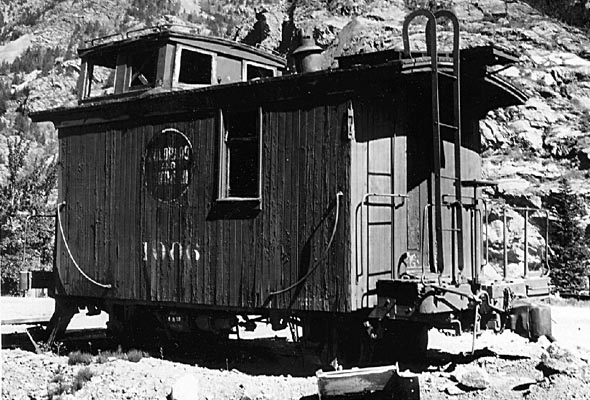
C&S four-wheel bobber caboose No. 1006 after abandonment in Silver Plume, Colorado. Sister car 1009 has been preserved at the Colorado Railroad Museum. Chris Lane Collection
Second is the story of the C&S train that was crossing South Park in snow flurries and late afternoon shadows. They were stopped by a large looming object on the tracks in front of them. When the crew got off they discovered a large hay stack. Wondering what in the world a hay stack was doing on the tracks, they looked down and noticed they were no longer on the tracks! Apparently they had jumped the track back at a grade crossing that had filled with snow and ice. Upon realizing what had happened the fireman is reported to have said, “Well, I sure thought she was running smoother and easier than she usually does!”
Third, is the story of the DSP&P locomotive that became caught in a snow drift in the mountains. They could not go forward because the snow was too deep for the wedge plow, mounted on the front of the loco, to handle. They couldn’t back up because snow had drifted in behind them. They had some tools and equipment with them. So, the story goes, they jacked the loco and tender up, individually, slid some rail pieces they had, under the wheels, greased the rails, and manually pushed the loco around and set it back on the track! Now, with its plow facing the shallower drifted snow they could get out. Reportedly this is the only time a loco has been turned, out on the road, without the use of a turntable, wye, or reverse loop! What fascinating stories! And there are more!

Looking for ways to battle the brutal winters and keep the lines open, various snowplow designs were tested on the C&S in the 1890. Photo courtesy Rick Steele
Not a legend, but certainly part of the history of the C&S, is the story of the snow plow trials held on the eastern approach to the Alpine Tunnel in the winter of 1890, between the Leslie brothers’ rotary plow and Orange Jull’s Snow Excavator. The Leslie won due to its greater ability to handle the sharp curves and light rail of the line.
Mysteries surrounding the road were mentioned earlier. These, too, are many and varied. The correct colors of various pieces of rolling stock and locomotives, the arrangement inside the large engine houses on the various passes, the reasoning behind the placement of track and many more are topics of frequent discussion.
The road is noteworthy for its use of advanced engineering practices on its structures. Most of the large bridges were iron from the very beginning. Depots were usually wood, but several were stone, or brick, from very early. Certainly, the engineering feat of the Devil’s Gate Viaduct Bridge on the Georgetown Loop was well-documented at the time, and served the railroad until the end of operations in the late 1930’s. Then there are the enclosed engine houses, complete with turntables, watering and coaling facilities, located at the top of various mountain passes. Or, how about the dance pavilions located at Silver Plume, Beaver Brook, and up on the Argentine Central, overlooking Silver Plume? There were the large ramped coaling docks located at Como, Dickey and Pine. This road was built with the idea of being around for a long time and had many very picturesque structures.
The depots were often unique. Some shared the same design, but depots like Forks Creek, Pitkin, Leadville, Dumont, Gunnison, Georgetown, Central City and many others, were all different in style from one another. Yet, they shared the C&S characteristics of deep overhanging eaves, ornate eve brackets and fancy wood work. Thirteen depots, or parts of them, are still standing!
Like several other Colorado narrow gauges, the C&S served mostly small towns. At these locations there was not the need for a dedicated switcher, as at Durango, Antonito, Alamosa, Chama and the like on the D&RGW. So, the road loco had to do the switching at these towns. In operation on a model railroad this provides more action for the road crew and these small towns are much easier to represent in miniature, than are large towns, or cities. It is easier to represent more of the context of the real railroad. The scene depicted is more realistic, because it can be more complete.
Finally, consider the possibility of actually modeling one of these roads. Interestingly, the C&S and its related roads are, in some ways, easier for a modeler to recreate than any of the other roads. In HOn3 you have a greater variety and number of kits, both of rolling stock and structures, than any other road! There are something like 67 separate HO structure kits available for modeling the related roads of the C&S. Nearly 30 rolling stock kits exist. Ready-to-run locomotives and cars are now available. There are twenty different models of brass C&S, and related roads, locomotives. C&S detail items abound — switchstands, stacks, domes, marker lights, brake wheels, brake systems, headlights, trucks, structure windows and doors, chimneys, and the like, are all readily available. So, modeling the C&S can be much easier than the other roads which are more often modeled.
In conclusion, I hope this look at the C&S and its related roads has given you more information about the line. Further, I hope it has given some of you enough insight into this particular Colorado narrow gauge to be intrigued with it and challenged to give a try at modeling it. If this thesis inspires others to write about their particular modeling preferences, then that is icing on the cake. Happy modeling of whatever road you choose!


